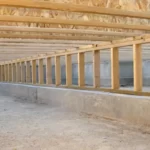Distinctions between structures and buildings
All buildings are structures. But all structures are not necessarily buildings.
Buildings and structures are both man-made constructions, but there are some key
differences between the two….
A building is generally considered to be a structure that is designed for human occupancy
and use. Buildings can include homes, office buildings, schools, hospitals, and other types of
structures that are intended to be lived or worked in. They are typically made of materials
such as wood, brick, stone, or concrete, and can be single or multi-story.
A structure, on the other hand, is a more general term that can refer to any type of built
object, whether it is intended for human use. Structures can include bridges, towers, dams,
and other types of constructions that are not intended for human occupancy. They can be
made of a variety of materials, including steel, concrete, or wood.
Purpose:
Building: The primary purpose of a building is to provide a functional space for people to
live, work, or carry out specific activities. Buildings are designed with the occupants’ needs
and comfort in mind.
Structure: Structures serve a wide range of purposes, and they may not always be intended
for human occupancy. For example, bridges are structures designed to facilitate the passage
of vehicles or pedestrians over a waterway or an obstacle.
Human Occupancy:
Building: Buildings are specifically designed for human occupancy, with amenities and
features catered to human needs.
Structure: Structures may or may not be designed for human occupancy. While some
structures, like buildings and stadiums, are meant for people, others, like bridges and
towers, are not intended for long-term occupancy.
Design Complexity:
Building: Buildings tend to be more complex in their design, as they require careful
consideration of factors like interior layout, HVAC systems, plumbing, and electrical
infrastructure to support the occupants’ needs.
Structure: Some structures can be relatively simple in design, such as basic bridges or small
culverts, while others, like skyscrapers or long-span bridges, require intricate engineering
and design considerations.
Architectural Elements:
Building: Buildings are characterized by their architectural elements, such as facades,
windows, doors, and interior design, which are vital for creating comfortable and
aesthetically pleasing spaces.
Structure: While some structures may have architectural elements, the emphasis is more on
the engineering and functional aspects of the construction.
Size and Scale:
Building: Buildings can vary widely in size, from small residential homes to massive
commercial skyscrapers.
Structure: Structures can also vary significantly in size, but the term is more inclusive and
encompasses various engineered constructions, irrespective of their size.
In summary, buildings are structures that are intended for human use, while structures are a
more general term that can refer to any type of built object. Buildings are a subset of
structures that are specifically designed for human habitation and use, whereas structures
encompass a wider range of engineered constructions that serve various purposes beyond
human occupancy.
Disclaimer: This content is provided solely for your review. Erusu Consultants takes no liability for this article. The reader is advised to form their own opinion. Please consult a Structural Engineer before making any final decisions.






